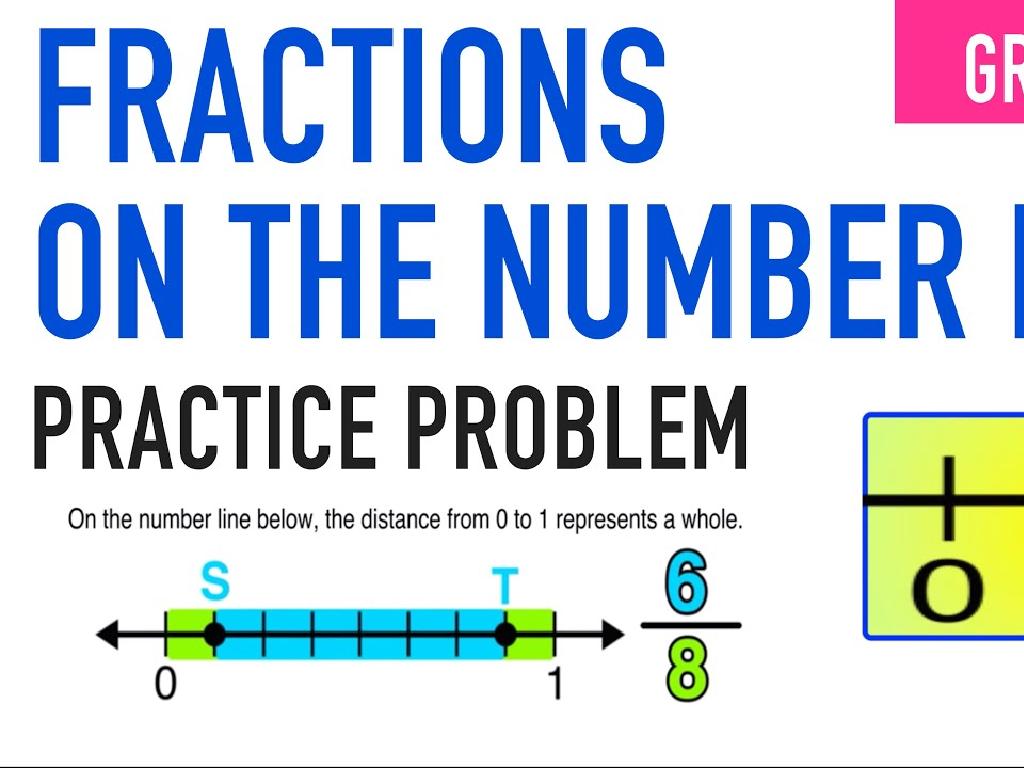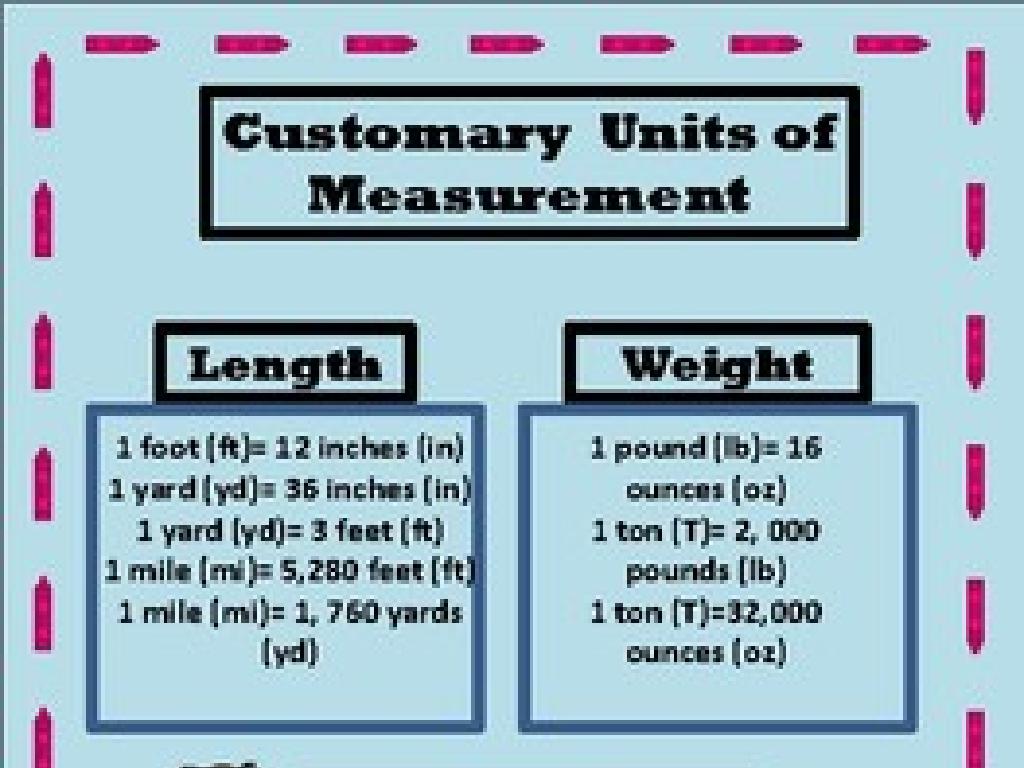Identify Earth'S Land Features Using Photographs
Subject: Social studies
Grade: Third grade
Topic: Geography
Please LOG IN to download the presentation. Access is available to registered users only.
View More Content
Today’s Adventure: Earth’s Land Features!
– Our planet’s diverse landscape
– Land features definition
– Parts of the land like mountains, valleys, and plains
– Examples of land features
– Mountains are high and rocky, valleys are low areas between hills, plains are large, flat lands
– Observing features in photos
– Use photos to see different land features and discuss what makes each one unique
|
This slide introduces students to the concept of Earth’s land features, setting the stage for a lesson on geography. Begin by discussing the variety of landscapes that make up our planet. Explain that land features are the different natural forms on the Earth’s surface. Provide examples such as mountains, valleys, and plains, and use photographs to help students visualize these features. Encourage students to think about the land features near their own community. The goal is for students to be able to identify and describe different land features from photographs, understanding that these are part of the Earth’s geography.
Exploring Geography: Earth’s Land Features
– Geography: Earth’s study
– It’s about landscapes, environments, and how they form.
– Landscapes and environments
– Mountains, valleys, plains, and rivers are parts of Earth’s landscapes.
– Human-environment relationships
– How people live with and change their surroundings.
– Understanding our world
|
This slide introduces the concept of geography to third-grade students, emphasizing its role in helping us understand the Earth’s landscapes, environments, and how humans interact with these spaces. Geography is not just about maps; it’s about the physical features of the planet and the ways in which we live and adapt to our environments. Encourage students to think about their own community and the geographical features they see every day. Ask them to consider how these features affect their lives and the lives of those around them. This will help them grasp the importance of geography in their daily experiences.
Exploring Earth’s Land Features
– Mountains: Earth’s natural skyscrapers
– Tall and majestic, often reaching the clouds
– Valleys: The low points among hills
– Spaces between mountains or hills, like a bowl
– Plains: Vast stretches of flat land
– Wide open spaces, great for farming and animals
– Islands: Land in a water blanket
– Surrounded by water, can be big or small
|
This slide introduces students to various land features they can find on Earth. Mountains are described as large landforms that rise above the surrounding area, often capped with snow. Valleys are introduced as the lower areas found between hills or mountains, usually with a river running through them. Plains are described as wide expanses of flat or gently rolling land, often used for agriculture. Islands are explained as pieces of land completely surrounded by water. Use photographs to help students visualize each land feature. Encourage them to think of examples they may have seen in real life or in pictures. This will help them connect the concept to the real world and better understand the diverse topography of our planet.
Exploring Mountains
– Mountains are very tall
– They can have snowy peaks and are majestic
– Formed by Earth’s crust
– Movements like pushing and folding make mountains
– Example: Rocky Mountains
– The Rockies stretch across North America
– Mountains have different shapes
|
This slide introduces students to the concept of mountains as a significant land feature on Earth. Emphasize the height and majesty of mountains, often characterized by their snowy peaks. Explain that mountains are formed by the movements of the Earth’s crust, such as when tectonic plates push against each other. Use the Rocky Mountains as a concrete example to help students visualize and understand the concept. Discuss the various shapes and types of mountains, and how they can be identified in photographs. Encourage students to think about other mountain ranges they may know and how they might differ in appearance.
Exploring Valleys
– Valleys: Earth’s low areas
– Valleys are like big ditches in the ground, often with rivers
– Formed by erosion and rivers
– Water flow wears away land over time, creating valleys
– Example: The Grand Canyon
– The Grand Canyon is a famous valley made by the Colorado River
|
This slide introduces valleys as significant land features on Earth. Explain that valleys are like large ditches or grooves in the landscape, which are usually lower than the surrounding land. They often have rivers flowing through them, which can carve out the valley over time through a process called erosion. Use the Grand Canyon as a concrete example of a valley, highlighting how the Colorado River has shaped it over millions of years. Encourage students to think of valleys as places where water has shaped and changed the Earth’s surface, creating unique and often beautiful landscapes.
Exploring Plains
– Plains are vast flat lands
– Wide areas where the land is mostly level
– Ideal for farms and cities
– Because plains are flat, it’s easier to grow crops and construct buildings
– The Great Plains as an example
– A large area of flat land in the central United States
|
This slide introduces students to the concept of plains as a type of Earth’s land features. Plains are characterized by their wide, open spaces and minimal changes in elevation, making them one of the most useful landforms for human activities such as agriculture and urban development. Use photographs of The Great Plains to give students a concrete example of plains. Discuss how the flatness of plains contributes to their suitability for farming and building. Encourage students to think about other examples of plains they may know or have seen in pictures or during travels.
Exploring Islands: Earth’s Land Features
– Islands: Land surrounded by water
– An island is any piece of land smaller than a continent and completely surrounded by water.
– Formed by volcanoes or sand/coral
– Volcanic islands like Hawaii are born from oceanic volcanoes erupting, while others form from sand and coral accumulation.
– Example: Hawaii
– Hawaii is an example of a volcanic island, known for its beautiful landscapes and rich culture.
|
This slide introduces students to the concept of islands as a type of land feature on Earth. It explains that islands are entirely surrounded by water and can be created through different natural processes, such as volcanic activity or the accumulation of sand and coral. The example of Hawaii helps students visualize and understand the concept of a volcanic island. Encourage students to think of other islands they know and discuss how they might have been formed. Show photographs of various islands, including both volcanic and coral/sand islands, to provide visual context and enhance understanding.
Exploring Earth’s Land Features
– Observe photographs of land features
– Recall characteristics of each feature
– Think about size, shape, and location
– Discuss what makes each unique
– Mountains are tall and rocky, while plains are flat and wide
– Identify features in class activity
|
This slide is designed to engage students in a visual learning activity where they will apply their knowledge of land features to real-world examples. Begin by displaying photographs of various land features such as mountains, valleys, plains, and rivers. Encourage the students to observe closely and recall the characteristics of each land feature discussed in previous lessons, such as their size, shape, and location. Facilitate a class discussion on the unique aspects of each photograph and how they can identify the land features within them. The class activity will involve students working individually or in groups to label or describe the features in the photographs, reinforcing their understanding of the topic. Provide guidance and support as needed, and ensure that each student has an opportunity to participate.
Class Activity: Land Feature Detectives
– Work in groups with photo sets
– Use detective skills to identify features
– Look for hills, valleys, rivers, and more
– Discuss findings within the group
– Present your land feature discoveries
– Explain how you identified each feature
|
This interactive class activity is designed to engage students in learning about Earth’s land features through direct observation. Divide the class into small groups and provide each with a set of photographs depicting various landforms. Encourage students to act as ‘detectives’, examining the photos to identify hills, valleys, rivers, mountains, and other features. They should discuss their observations within their groups to reach a consensus. After the investigation, each group will present their findings to the class, explaining the clues that led them to identify each land feature. This activity promotes teamwork, observation skills, and presentation skills. Possible variations of the activity could include using different sets of photos for each group, focusing on specific types of landforms, or even having students bring in their own photographs from home.
Great Job, Young Geographers!
– Congratulations on learning land features!
– You can now identify Earth’s geography.
– Mountains, valleys, plains, and hills are no longer a mystery.
– Continue exploring your surroundings.
– Use your new skills to observe nature during trips or walks.
– Keep being curious about the world!
|
This slide is meant to celebrate the students’ achievements in learning how to identify various land features of Earth using photographs. It’s important to encourage them to apply this knowledge outside of the classroom by observing their environment during family trips, walks in the park, or even looking at pictures in books or online. Reinforce the idea that geography is all around them and that they can be explorers in their own right. Encourage them to ask questions and stay curious about the natural world. This will not only solidify their understanding but also spark a lifelong interest in geography.






